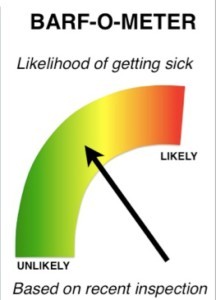My philosophy on disclosing restaurant inspection information hasn’t wavered much in the past 10 years: Make inspection results public and communicate them meaningfully to help patrons make decisions. There’s a patchwork approach to disclosure throughout the world: happy faces, letter grades, number grades or the not-well-used barf-o-meter.
Whatever the system is, it’s necessary to pull back the curtain on what happens when inspectors are around. The transparency not only builds trust in the system, but also allows folks to choose businesses based on their own risk tolerance.
But the inspection grades, alone, don’t tell patrons whether they are likely to get sick eating at the restaurant. To get a better picture the hungry (and interested) have to dive a bit deeper into what’s behind the grade – and if there are historical issues that keep coming up. That’s kind of what I told Lydia Coutré of Star News.
The posted score offers transparency and a point-in-time snapshot of the establishment’s food safety procedures. But because there’s a wide range of issues that could put a restaurant at a 100, a 95 or an 85, that number alone isn’t the full picture, said Ben Chapman, food safety specialist and associate professor at N.C. State University.
It’s just one day and could be a good or bad day for the facility and staff.
“The grading system doesn’t tell you whether you should eat at a restaurant or not,” Chapman said.
Whether a consumer “should” eat somewhere is up to the market.
Restaurants can earn a score as low as 70. Below that, a facility’s permit would be revoked.
Alicia Pickett, New Hanover environmental health supervisor, said as long as the restaurant falls in that 70 to 100 range, “it’s for the public to decide.”
A mid-80s score could come from several issues adding up such as cracked tiles, broken lights and dirty baseboards, Chapman said. Or it could represent an organizational problem where hand washing isn’t valued.
Doing more research into what violations led to the score and looking at trends over time can give consumers a better picture of the food safety procedures at a facility, Chapman said.
If there’s an issue that shows up time and time again and isn’t being fixed, that represents a different problem than a restaurant that was dinged for cracked equipment that they fixed or replaced by the next inspection.
The George on the Riverwalk Executive Chef Larry Fuller knows what it takes to get high marks – and what would leave a restaurant with a lower score.
When he goes out to eat, it’s the first thing he looks at. And he’s not alone, he said.
“We get customers coming in like we came here because of your health grade,” Fuller said of the 100 score the restaurant earned at its most recent inspection. “I mean they say that directly to our waitresses and our waiters, and I think that’s awesome.”
The 100 score is a point of pride for Fuller and his staff, and he wants to maintain that number.
“The health grade is a big part of the restaurant business,” Fuller said. “It’ll make or break your restaurant.”
But the grade may not tell you much about the food handling practices when the inspector isn’t around.
